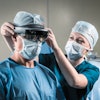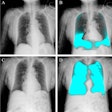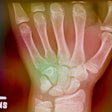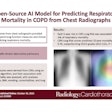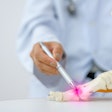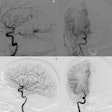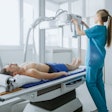What if routine imaging studies like chest CT exams and x-rays were also utilized to screen for risk of conditions such as cardiovascular disease, osteoporosis, and cancer? A growing body of evidence suggests that this approach -- called opportunistic screening -- could enable earlier interventions for at-risk patients.
For this special edition, AuntMinnie highlights compelling opportunistic screening research, AI enablement, and how opportunistic screening is becoming viewed as a potentially proactive healthcare strategy and research tool.
The use of AI algorithms to assess the risk of major adverse cardiac events (MACE) on routine chest CT exams is a particularly active area.
Cardiovascular risk
For example, researchers from Mass General Brigham (MGB) in Boston and Veterans Affairs (VA) Long Beach Healthcare System in California have developed a deep-learning algorithm designed to provide cardiovascular risk evaluation from noncardiac CT exams, potentially enabling physicians to engage with patients before their heart disease advances to a cardiac event.
"Millions of chest CT scans are taken each year, often in healthy people, for example, to screen for lung cancer,” stated Hugo Aerts, PhD, director of MGB’s Artificial Intelligence in Medicine (AIM) Program, in a statement discussing the researchers’ recently published NEJM AI paper. “[Our research indicates] that important information about cardiovascular risk is going unnoticed in these scans.”
To make use of that data, they developed a deep-learning algorithm to automatically quantify coronary artery calcium (CAC) on nongated CT exams. Traditionally, CAC is quantified using “gated” CT scans that synchronize to the heartbeat to reduce motion during the scan. However, most routine chest CT exams performed for routine clinical purposes are nongated.
After testing their algorithm on low-dose chest CT exams to simulate opportunistic screening, the researchers found that it was highly accurate for identifying patients at moderate cardiovascular risk and was also predictive of 10-year all-cause mortality. What’s more, nearly all patients identified by the model as having CAC scores over 400 would benefit from lipid-lowering therapy.
“Using AI for tasks like CAC detection can help shift medicine from a reactive approach to the proactive prevention of disease, reducing long-term morbidity, mortality, and healthcare costs,” wrote first author Raffi Hagopian, MD, of Veterans Affairs (VA) Long Beach Healthcare System in California.

RSNA 2025
The momentum propelling opportunistic screening will also be evident at RSNA 2025.
Targeting a similar application as the MGB/VA team, Elshan Abdullayev, MD, chief of radiology at Saf Hospital in Azerbaijan, will present research on an internally developed AI-powered tool designed to automatically quantify CAC scores for risk stratification on routine noncardiac chest CTs.
"Implementation could prevent thousands of cardiovascular events annually through early identification of high-risk asymptomatic patients, representing a paradigm shift toward proactive population health management using existing imaging infrastructure," Abdullayev said in the scientific abstract.
Abdullayev and colleagues tested whether AI-powered CAC scoring from noncardiac chest CTs could yield cardiovascular risk stratification equivalent to dedicated cardiac CT. They found that the algorithm had "excellent diagnostic accuracy" for CAC scoring.
Furthermore, of 2,847 patients with previously unknown cardiovascular risk, 23.4% were reclassified to higher risk categories, leading to preventive interventions in 18.2%, Abdullayev noted. Processing time averaged 12 seconds per case.
Diverse populations
Another group of researchers is also working to enhance early risk estimation of MACE on routine chest CT exams across diverse patient populations.
Traditional methods for estimating MACE risk that utilize only known clinical and demographic risk factors perform suboptimally, according to Amara Tariq, PhD, an assistant professor of biomedical informatics at Mayo Clinic College of Medicine and Science, and colleagues. Tariq's group has developed a 3D convolutional neural network model to enable a "causal intervention" approach.
In testing, their algorithm outperformed comparative models and generalized well to external data with a significant shift in patient populations, according to the researchers.
“Leveraging AI to analyze rich, underutilized data within routinely performed chest CTs holds significant promise for enhancing early MACE risk estimation across diverse patient populations beyond the capabilities of current clinical tools,” the authors wrote.
Emphysema
Meanwhile, researchers at Weill Cornell Medicine in New York have taken a different opportunistic screening approach, utilizing qualitative CAC and emphysema scores from low-dose CT (LDCT) exams to serve as biomarkers for cardiovascular disease and emphysema.
In their large, retrospective study analyzing baseline LDCT reports from an asymptomatic lung cancer screening (LCS) program, the researchers found that cardiovascular disease and chronic obstructive pulmonary disease were prevalent in a high-risk patient population. And these biomarkers on LDCT enabled significant changes in pulmonary and cardiovascular care, according to the group.
"Implementing structured reporting and downstream care pathways for these findings may enhance the clinical utility of LCS," wrote Corzo et al in their scientific abstract.
Osteoporosis/osteopenia
Osteoporosis and osteopenia highlight another encouraging segment of opportunistic screening research, for several reasons, including preventing fragility fractures.
Earlier this year, researchers from NYU Langone Health, the Harvey L. Neiman Health Policy Institute (HPI), and Massachusetts General Hospital (MGH) estimated that opportunistic bone density screening on CT exams could increase osteoporosis screening by 113% without additional imaging -- and save the healthcare enterprise almost $100 million annually.
Researchers from MGH have also externally validated an AI tool for opportunistic osteopenia and osteoporosis detection on chest radiographs. At RSNA 2025, postdoctoral research fellow Anushree Burade, MBBS, will share how an AI algorithm produced generalizable findings for differentiating between the three classes of bone mineral density (BMD).
“Given the global underutilization of dedicated osteoporosis screening with [dual-energy x-ray absorptiometry], such AI-based opportunistic screening using [chest x-rays] may help bridge the diagnostic gap," the researchers wrote in their abstract.
Another recent study found that AI analysis of chest x-rays would be a cost-effective approach to screen for osteoporosis in U.S. women ages 50 and over.
“These findings highlight the public health potential of AI-driven screening to improve early detection and address gaps in osteoporosis care,” wrote Mickael Hiligsmann, PhD, of Maastricht University in the Netherlands, and colleagues.
Emergency department scans
For people ages 50 to 65 who fall outside the traditional osteoporosis screening age, opportunistic use of chest x-rays obtained for other indications could potentially be used to identify patients with signs of bone demineralization in primary care settings.
Researchers at the University of Texas Health Science Center (UTHealth) in Houston say many older adults may unknowingly suffer from progressive bone loss and may be at risk of osteoporosis.
On independent review by a fellowship-trained emergency radiologist, 49 patients (12.6% of the total study population) were identified as having signs of bone loss on chest x-rays obtained through the emergency department at their large Level 1 trauma center. These patients, who included six men and 43 women, were scanned in relation to possible cardiopulmonary issues.
Of these 49, two had a “bone demineralization” comment in their reports.
"Currently, it is not standard practice for a radiology report to include demineralization status in the impression of the report for chest x-rays performed for emergencies and other nonskeletal indications, yet such practice could greatly benefit patients," said associate professor of radiology Naga Ramesh Chinapuvvula, MD, at UTHealth at Houston and colleagues.
Breast density
Among other clinical indications, automated breast density assessment offers another potential opportunity for opportunistic screening from chest CT exams.
In a retrospective study, researchers at Montefiore-Einstein in New York City benchmarked CT-derived density calculations against mammographic data. Automated breast tissue segmentation using an open-source, algorithm-calculated CT-derived percentage and volume density succeeded in 97.5% of cases, radiology resident Kai Jones, MD, and Edward Mardakhaev, MD, assistant professor of radiology at Montefiore-Einstein, reported in their presentation for RSNA 2025.
They concluded that automated, opportunistic breast density assessment from chest CT is feasible and highly accurate, achieving an area under the curve of nearly 0.899 across 647 chest scans, including those with technical limitations.
"These findings support exploring the integration of this automated method into clinical workflows to provide valuable breast cancer risk information from existing scans and guide screening recommendations," the authors wrote.
Other applications
These studies are just a sample of the work being done to advance opportunistic screening. Other talks at RSNA 2025 will share updates, for example, on efforts to apply AI for opportunistic screening for pancreatic ductal adenocarcinoma, assessing risk of diabetes, measurement of cardiovascular aging trajectories, body composition analysis to stratify risk of metastatic renal cell carcinoma, and many other clinical indications.
For radiologists and other healthcare providers interested in opportunistic screening, please refer to the RSNA 2025 catalog for additional sessions, including those highlighted here:
AI-driven coronary artery calcium scoring and aortic valve analysis. S2-STCE1-1, November 30, 10:30 a.m.-10:40 a.m., Learning Center Theater 1.
Osteoporosis and osteopenia chest radiograph-based AI model, external validation. M3-SSCH03-1, December 1, 9:30 a.m.-9:40 a.m., Room S501.
Causal intervention to MACE risk estimation. R1-SSCA09-05, December 4, 8:40 a.m.-8:50 a.m., Room E353C.
Opportunistic breast density assessment (T3-STCE1-1) and opportunistic screening impact on downstream cardiopulmonary care (T3-STCE1-2), December 2, 10 a.m.-10:20, Learning Center Theater 1.




